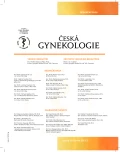-
Medical journals
- Career
Hirsutism
Authors: M. Fanta
Authors‘ workplace: Gynekologicko-porodnická klinika 1. LF UK a VFN, Praha, přednosta prof. MUDr. A. Martan, DrSc.
Published in: Ceska Gynekol 2017; 82(3): 237-242
Overview
Objective:
Overview of excessive hair growth in women, hirsutism. Although women with hirsutism typically present because of cosmetic concerns, the majority also have an underlying endocrine disorder.Design:
Review article.Setting:
Department of Gynecology and Obstetrics, General Faculty Hospital and 1st Faculty of Medicine of Charles Universtity, Prague.Material and methods:
Hirsutism is a clinical diagnosis defined by the presence of excess terminal hair growth (dark, coarse hairs) in androgen-sensitive areas. It affects between five and ten percent of women of reproductive age. It may be the initial, and possibly only, sign of an underlying androgen disorder.Conclusions:
The most common cause of hirsutism is polycystic ovary syndrome (PCOS). In some cases, hirsutism is mild and requires only reassurance and local (nonsystemic) therapy, while in others it causes significant psychological distress and requires more extensive therapy. In case of rapid progressive hair growth should be first exclude androgen-secerning tumour (ovarian, adrenal) as the most serious condition.Keywords:
hirsutism, androgens, testosterone, androgen-secerning neoplasm, combined oral contraeptives, antiandrogens
Sources
1. Burkman, RT. Jr. The role of oral contraceptives in the treatment of hyperandrogenic disorders. Am J Med, 1995, 98, p. 130S.
2. Cosma, M., Swiglo, BA., Flynn, DN., et al. Clinical review: Insulin sensitizers for the treatment of hirsutism: a systematic review and metaanalyses of randomized controlled trials. J Clin Endocrinol Metab, 2008, 93, p. 1135.
3. DeUgarte, CM, Woods, KS., Bartolucci, AA., Azziz, R. Degree of facial and body terminal hair growth in unselected black and white women: toward a populational definition of hirsutism. J Clin Endocrinol Metab, 2006, 91, p. 1345.
4. Escobar-Morreale, HF., Carmina, E., Dewailly, D., et al. Epidemiology, diagnosis and management of hirsutism: a consensus statement by the Androgen Excess and Polycystic Ovary Syndrome Society. Hum Reprod Update, 2012, 18, p. 146.
5. Ferriman, D., Gallwey, JD. Clinical assessment of body hair growth in women. J Clin Endocrinol Metab, 1961, 21, p. 1440.
6. Granger, LR., Roy, S., Mishell, DR. Jr. Changes in unbound sex steroids and sex hormone binding globulin-binding capacity during oral and vaginal progestogen administration. Am J Obstet Gynecol, 1982, 144, p. 578.
7. Heinemann, LA., Will-Shahab, L., van Kesteren, P., et al. Safety of cyproterone acetate: report of active surveillance. Pharmacoepidemiol Drug Saf, 1997, 6, p. 169.
8. Cheewadhanaraks, S., Peeyananjarassri, K., Choksuchat, C. Clinical diagnosis of hirsutism in Thai women. J Med Assoc Thai, 2004, 87, p. 459.
9, Knochenhauer, ES., Key, TJ., Kahsar-Miller, M., et al. Prevalence of the polycystic ovary syndrome in unselected black and white women of the southeastern United States: a prospective study. J Clin Endocrinol Metab, 1998, 83, p. 3078.
10. Knopp, RH., Broyles, FE., Cheung, M., et al. Comparison of the lipoprotein, carbohydrate, and hemostatic effects of phasic oral contraceptives containing desogestrel or levonorgestrel. Contraception, 2001, 63, p. 1.
11. Madden, JD., Milewich, L., Parker, CR. Jr., et al. The effect of oral contraceptive treatment on the serum concentration of dehydroisoandrosterone sulfate. Am J Obstet Gynecol, 1978, 132, p. 380.
12. Martin, KA., Chang, RJ., Ehrmann, DA., et al. Evaluation and treatment of hirsutism in premenopausal women: an endocrine society clinical practice guideline. J Clin Endocrinol Metab, 2008, 93, p. 1105.
13. Porcile, A., Gallardo, E. Long-term treatment of hirsutism: desogestrel compared with cyproterone acetate in oral contraceptives. Fertil Steril, 1991, 55, p. 877.
14. Rosenfield, RL. Clinical practice. Hirsutism. N Engl J Med, 2005, 353, p. 2578.
15. Vrbíková, J., Fanta, M., Koryntová, D. Syndrom polycystických ovarií. Praha: Maxdorf, 2014.
16. Waggoner, W. Total testosterone and DHEAS levels as predictors of androgen-secreting neoplasms: a populational study. Gynecol Endocrinol, 1999, 13(6), p. 394–400.
Labels
Paediatric gynaecology Gynaecology and obstetrics Reproduction medicine
Article was published inCzech Gynaecology

2017 Issue 3-
All articles in this issue
- Retrospective analysis of monochorionic twin pregnancies born in the Institute for the Care of Mother and Child between 2012–2015
- Rare forms of feto-fetal transfusion in a clinical practice
- Complications arising out of insufficient reporting of clinical data to the pathologist investigating placentas
- HELLP syndrome requiring therapeutic plasma exchange due to progression to multiple organ dysfunction syndrome with predominant encephalopathy, respiratory and renal insufficiency
- Two years of pharmacological termination of pregnancy in the Silesian hospital Opava, success and lessons
- The importance of maternal microbiome in pregnancy
- Ultrasound staging of stage I-II endometrial cancer, analysis of own file in the years 2012–2016
- Aggressive angiomyxoma – case report
- Current FIGO staging classification for cancer of ovary, fallopian tube and peritoneum
- Hirsutism
- Complications tension-free vaginal tape surgery
- Czech Gynaecology
- Journal archive
- Current issue
- Online only
- About the journal
Most read in this issue- Complications tension-free vaginal tape surgery
- Current FIGO staging classification for cancer of ovary, fallopian tube and peritoneum
- Hirsutism
- Retrospective analysis of monochorionic twin pregnancies born in the Institute for the Care of Mother and Child between 2012–2015
Login#ADS_BOTTOM_SCRIPTS#Forgotten passwordEnter the email address that you registered with. We will send you instructions on how to set a new password.
- Career

